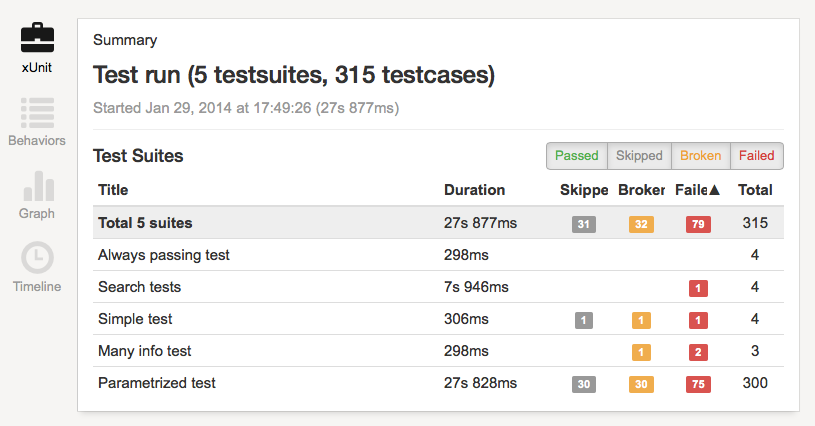-
Notifications
You must be signed in to change notification settings - Fork 167
Home
Please consider using allure2 instead. The source code of allure 2 available at https://github.com/allure-framework/allure2 , and docs can be found at https://docs.qameta.io/allure/latest/
Allure Framework is a flexible lightweight multi-language test report tool with the possibility to add screenshots, logs and so on. It provides modular architecture and neat web reports with the ability to store attachments, steps, parameters and many more.
To use Allure, you only need to complete two steps:
- Gather information about tests
- Generate a report
In this step, all information about running tests is saved to XML files with a predefined format. For this purpose, we provide so-called adapters - small libraries that are attached to particular test frameworks and know how to extract test information to XML. For more information, select one of the supported test frameworks:
- Behat
- Codeception
- Cucumber
- Cucumber JS
- Cucumber JVM
- Jasmine
- JBehave
- JUnit 4
- Karma
- Mocha
- MSTest
- Nose
- NUnit
- PHPUnit
- PyTest
- RSpec
- ScalaTest
- SpecFlow
- Specs
- Spock
- TestNG
Also see various examples on how to use adapters.
Once the XML files have been created by the adapter, you can generate an Allure report using one of the following tools:
- Use Allure Command Line Tool to generate a report by running a console command.
- Use Allure Jenkins Plugin to generate a report as a Jenkins job artifact.
- Use Allure Teamcity Plugin to generate a report as a Teamcity job artifact.
- Use Allure Bamboo Plugin to generate a report as an Atlassian Bamboo plan artifact.
- Use Allure Maven Plugin to generate a report during a Maven build.
- Use Gradle Allure Plugin to generate a report by running Gradle task.
This section describes the main features of Allure. For example, you can group your tests by stories or features, attach files, and distribute assertions over a set of custom steps, among other features. All features are supported by Java test frameworks, so we only provide Java examples here. For details on how a particular adapter works with the test framework of your choice, refer to the adapter guide.
- aShot - WebDriver Screenshot utility. Take screenshots, crop, prettify, compare.
- HTML Elements - A Java framework that provides easy-to-use interaction with page elements in webpage tests.
- Properties - A Java library for populating beans with system environment properties in a simple and convenient way.
- Perspective - API and shell to orchestrate multiple clouds.
